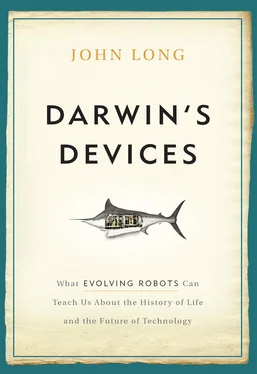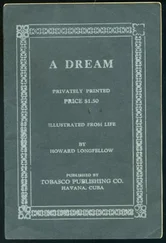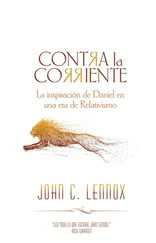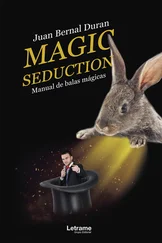Spoken by Don Lockwood, in the movie Singing in the Rain, as he attempts to recast his past dowdy Vaudeville career in the color of his current Hollywood persona.
I’m playing a bit fast and loose with my use of “concerted” here, so please help me out by keeping in mind that a correlation is only the first piece of evidence for concerted evolution. Because we’ve defined concerted evolution to be causally based, we also want to show how, in this case, the number of vertebrae improves the acceleration ability of the PreyRo. I’ll show you evidence for this in some experiments that we run on the Tadro-derived MARMT system in the next chapter.
This opening line is from the movie, The Adventures of Buckaroo Bonzai Across the Eighth Dimension , 1984.
Even though we spoke at length in Chapter 2 about evolutionary theory, you may hunger for more (or for a refresher). Consider starting at this website, “Understanding Evolution,” \evolution.berkeley.edu/evolibrary/home.php.
You may recognize this problem from our discussion of scientific inference in Chapter 2. We only ever see a limited number of cases of all of the phenomena we seek to understand. Once we infer some property of all possible cases from witnessing just a few, we are always worried, with good reason, about the other cases. What if one of those unseen cases falsifies my idea of how the system is working? With that very real concern in mind, we conduct additional tests, make sure that we sampled the study cases within the system in a way that best represents all of the possible cases, and “prove” by being unable to disprove after repeated attempts to do so.
Some folks argue that this question is the motivation for most of evolutionary biology. It was addressed by Sewall Wright, who, in the first part of the twentieth century, extended individual genetics to the genetics of populations. In so doing, he helped propel the modern synthesis of evolutionary theory, which includes his concept of an “adaptive landscape,” wherein a population has an evolutionary path that is determined by, you guessed it, history, selection, and random genetic effects. Check out his paper: Sewall Wright, “The Roles of Mutation, Inbreeding, Crossbreeding and Selection in Evolution,” Proceedings of the Sixth International Congress of Genetics 1 (1932): 356–366. The theory of adaptive landscapes, though modified, is currently used to study, for example, the pathways of molecular evolution: F. J. Poelwijk, D. J. Kiviet, D. M. Weinreich, and S. J. Tans, “Empirical Fitness Landscapes Reveal Accessible Evolutionary Paths,” Nature 445, no. 7126 (2007): 383–386.
This question springs from Steven J. Gould’s point about the importance of historical contingency. He argues that chance events in life make it highly unlikely that any species would evolve along the same path given a second opportunity to do so. Steven J. Gould, Wonderful Life: The Burgess Shale and the Nature of History (New York: W. W. Norton, 1989). Others argue that chance plays less of a role and that some forms have a high-probability of re-evolving. The genetics of developmental systems may constrain those possibilities. For a great introduction to that subject, read Sean B. Carroll, Endless Forms Most Beautiful: The New Science of Evo Devo and the Making of the Animal Kingdom (New York: W. W. Norton, 2005).
This question is a variant on these: Why is morphospace clumped? Why is biodiversity limited? What kinds of life-forms are physically possible? Genetically possible?
We calculate the selection vector as follows. First, the fitness scores determine who gets to mate. For PreyRo, the top three out of six get to mate, with the first-, second-, and third-place winners contributing to six, four, and two gametes, respectively, to the mating pool. Second, before we mutate those gametes or allow them to join to make offspring, we calculate the average values of the traits of the pre-mutation and pre-mating offspring. Third, this average of the traits is the position of the head of the selection vector’s arrow, with the vector’s tail anchored at the average of the parental population.
Warning: I made the peaks on this map in an intuitive and qualitative manner. In other words, I guessed. Well, it’s a bit better than guesswork, but not much, given how little data we’ve got here. Knowing that the selection vectors point uphill, I knew where at least some peaks or ridges needed to be. The guesswork comes in as follows. For the selection vectors from generations one and two, I assumed that they were pointing to a ridge. I could have assumed that they pointed to two separate peaks. I didn’t, though, because the direction that they point is similar, south-south-east for generation one and south-east for generation two, and I took that to mean that they were pointing at the same adaptive structure. This guesswork shows you how much data you would need to create a comprehensive adaptive landscape.
C. W. Liew and M. Lahiri, “Exploration or Convergence? Another Meta-Control Mechanism for GAs,” in Proceedings of the 18th International Florida Artificial Intelligence Research Society Conference, 251–257 (Clearwater Beach, FL: AAAI Press, 2005).
“Phenomenal cosmic power! Itty-bitty living space!” said the genie in Aladdin , the 1992 Disney film.
Thanks to Charles Dickens.
General Kurtz in Francis Ford Coppola’s 1979 film Apocalypse Now .
Barbara Webb, “Can Robots Make Good Models of Behaviour?” Behavioral and Brain Sciences 24, no. 6 (2001): 1048.
Ibid., 1049.
Marcel Proust, À la recherche du temps perdu , translated by C. K. Scott Moncreiff and Terence Kilmartin as Remembrance of Things Past (New York: Vintage Books, 1982).
Christopher McGowan, The Dragon Seekers: How an Extraordinary Circle of Fossilists Discovered the Dinosaurs and Paved the Way for Darwin (New York: Basic Books, 2001).
H. T. de la Beche and W. D. Conybeare, “Notice of the Discovery of a New Animal, Forming a Link Between the Ichthyosauru s and Crocodile, Together with General Remarks on the Osteology of Ichthyosaurus ,” Transactions Geological Society London 5 (1821): 559–594.
Richard Forrest has created and maintains an excellent site on plesiosaurs that you should visit: \plesiosaur.com/. Dr. Adam Stuart Smith also has an excellent site that features his own research: www.plesiosauria.com/index.html.
The term “plesiosaur” can be confusing. For example, within the Order Plesiosauria, we’ve got the short-necked Pliosauroidea and the long-necked Plesiosauroidea as Suborders. When I use the term plesiosaur here, I include all members of the Order, after Adam Stuart Smith (www.plesiosauria.com/classification.html). Just keep in mind that some folks prefer to talk about “true plesiosaurs” as just the long-necked forms, leaving pliosaurs to the side.
Carl Zimmer, At the Water’s Edge: Fish with Fingers, Whales with Legs, and How Life Came Ashore but Then Went Back to Sea (New York: Touchstone, 1998).
Читать дальше












